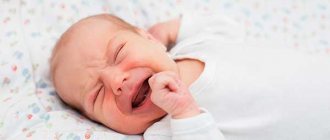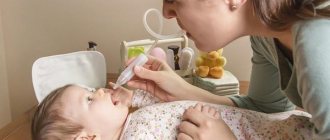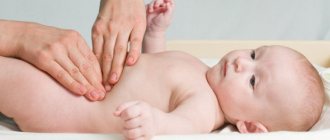Can a child cough due to snot?
One of the common causes of cough is a large amount of mucous secretions in the nasopharynx. Coughing from snot can occur at any time, but children cough more often at night. In a horizontal position, the mucous secretion does not come out through the nasal passages, but flows inward, irritating the respiratory tract.
When a pediatrician performs auscultation, wheezing and extraneous noises are not detected, the doctor can confirm that breathing is clear and even. In this case, the cause of the development of the cough reflex is the mucous secretions produced in the nasal cavity.
The nature of cough with rhinitis depends on the volume of discharge that flows down the back wall of the nasopharynx. A dry cough with snot occurs if mucus constantly gets into the larynx and trachea. This is how the child’s body gets rid of foreign bodies in the respiratory tract.
Thanks to the cough reflex, the possibility of mucus entering the bronchial tree is prevented. If they drain into the lower respiratory tract, breathing will become difficult.
A wet cough from snot occurs in situations where mucous secretions from the nasopharynx flow into the trachea. With bronchospasm, the child begins to cough it up, and the sputum comes out through the mouth. This development of events is possible when the baby’s snot has a consistency similar to water and flows uncontrollably. Due to mucus entry, the functioning of the respiratory system may be impaired. In children, such a wet cough, which appears due to snot, often provokes the development of secondary inflammation in the bronchi and trachea.
Parents should be alerted to a wet, strong cough in children who develop thick snot in their nose. They cannot drain into the larynx, so it is necessary to show the baby to the pediatrician. There is a high probability that the inflammatory process affected not only the nose, but also the lower respiratory tract.
Folk remedies
We treat a strong wet cough with black radish and honey!
For a wet cough in a child, you can use traditional methods of treatment. Popular recipes that will help get rid of a productive cough:
- Black radish with honey. Take a small radish, peel and remove the pulp. Next, add 2 teaspoons of honey into the hole. Leave it like this for 12 hours. During this time, the radish will release juice. It should be given to the child in a small spoon several times a day.
- Badger fat. It needs to be rubbed into the chest. You can buy it at any pharmacy.
- Milk with figs. A popular recipe for treating wet cough. Heat one and a half glasses of milk and add 1 fig. Cover the pan with a lid and leave to boil for 30 minutes. Allow to cool and drink for your child before bedtime.
- Onion juice with honey. Take a few onions, chop finely and boil. Next, leave to infuse for 3 hours and add 50-100 g of honey. Give the child 1/3 glass 3-4 times a day.
- Liquorice root. Grind it, pour 200 ml of boiling water and place in a water bath for 20 minutes. After this, leave for an hour and strain. If necessary, you can add honey. Give the child a tablespoon 3 times a day.
Compresses have a great healing effect in combination with medications. The consequences of a wet cough can be eliminated with the help of mustard plasters. However, this procedure should only be carried out after consulting a doctor.
Main reasons
Parents of children under 3 years of age are more likely to experience a reflex cough that appears against the background of rhinitis. The likelihood of developing such a problem in a 1-year-old child is higher than in a schoolchild. This is due to the peculiarities of the anatomical structure of the respiratory tract in children. In addition, at this age, children cannot blow out mucus that has accumulated in the nose.
Most often, the reflex cough reflex appears at night and after sleep. In this case, the child will complain not only about snot and cough. Discomfort is caused by a sore throat, rising temperature, swollen nasal mucosa, causing nasal congestion.
Among the main causes of rhinitis, which leads to cough, are:
- damage to the respiratory tract by viruses and bacteria;
- allergic reactions;
- improper indoor microclimate (drying of mucous membranes due to excessively dry air);
- entry of a foreign body into the nasal cavity;
- enlarged adenoids;
- anatomical features of osteochondral tissue, changes in structure as a result of injuries;
- dysregulation of the tone of blood vessels passing through the nasal cavity.
Sometimes a child coughs and suffers from increased production of mucous secretions due to malfunctions of the digestive organs. If you have problems with the stomach, pancreas, or gall bladder, the upper parts of the gastrointestinal tract—the pharynx and nasopharynx—are affected. Their irritation leads to the development of chronic inflammation and causes increased production of mucous secretion.
Causes of severe cough
Does your child have a severe wet cough? Looking for a reason
Typically, a wet cough occurs against the background of acute respiratory diseases, which is accompanied by other symptoms and never manifests itself in isolation.
Possible causes of a wet cough:
- Pneumonia
- Obstructive bronchitis
- Rhinitis
- Lung abscess
- Tuberculosis
If a wet cough is not accompanied by fever, the cause may be allergic diseases or bronchial asthma.
Diseases can be differentiated by sputum discharge.
If sputum comes out in large quantities, this indicates bronchitis or tracheitis. Rusty sputum indicates the development of pneumonia. When the upper respiratory tract becomes inflamed, watery sputum accumulates.
If the sputum is purulent with an unpleasant odor, then this indicates the development of a lung abscess or bronchiectasis. A sign of bronchial asthma is the discharge of viscous, glassy sputum.
Dangerous symptoms: when to see a doctor
It is necessary to urgently call a doctor if the cough occurs suddenly and the child cannot clear his throat for a long time. Parents should be wary if the following symptoms are present along with a wet cough:
- Dyspnea.
- Fever for 3 days.
- Refusal to eat.
- The appearance of wheezing.
- Green sputum streaked with blood.
You should immediately consult a doctor if you have these symptoms and your cough does not go away within 3 weeks.
How and how to treat a child’s cough from snot
Before starting treatment, it is necessary to determine the reason for the cough and rhinitis. It is important to stop the source of infection and normalize nasal breathing. A cough that appears from a runny nose cannot be ignored; it can provoke the development of pneumonia.
In infants, excess mucus in the nasopharynx, which flows down the back wall, can cause worse weight gain. Due to difficulties with nasal breathing, children of the first year of life have difficulty sucking milk.
If during rhinitis you can see mucus flowing down the back wall, then a combination therapy regimen is prescribed. Necessary:
- change the microclimate in the room;
- regularly rinse the nasal passages;
- use vasoconstrictor drops.
Inhalation with a nebulizer
Important! At elevated body temperature, inhalation is prohibited
You can relieve the symptoms of a wet cough using inhalations. For mild forms of respiratory tract diseases, agents are used that moisturize the mucous membrane and do not cause irritation. For this purpose, you can use ordinary mineral water and saline solution.
To treat severe forms of diseases with a characteristic purulent inflammatory process, medications are used: Ambroxol, Ambrohexal, Lazolvan, Fluimucil, Rotokan, Sinupret, etc. Any of these drugs is diluted in saline in a 1:1 ratio. First, saline solution is poured into the device, and then the medicine. The nebulizer chamber should be filled to 2-4 ml of solution.
The nebulizer sprays the medicine into small particles and distributes it evenly throughout the respiratory tract.
As a result, mucus secretion increases, blood circulation increases and the mucous membrane is restored. To achieve a positive result, you must adhere to certain recommendations:
- The procedure should be carried out 1-1.5 hours after eating.
- Breathe for 5-7 minutes.
- You should not talk during inhalation.
- After the procedure, you should not eat or drink liquids for an hour.
- Inhalations should be carried out 2-4 times a day.
- You cannot do inhalations based on herbal decoction to avoid blockage.
It is prohibited to give inhalations to a child using a nebulizer if:
- High temperature.
- Allergic reaction to drugs.
- Heart failure.
- Bleeding from the nose.
- Arrhythmias.
- Hemoptysis.
Inhalations can be performed on children from an early age. This method of treating cough is safe and effective.
Useful video: signs of bronchitis in a child
Causes of persistent cough and the best way to treat it
Prevention of cough in children is aimed at preventing the development of acute viral infections. Basic preventive measures:
- A balanced diet with sufficient intake of nutrients, vitamins and microelements.
- You should regularly walk in the fresh air.
- Compliance with personal hygiene rules.
- It is necessary to harden the body (take water treatments, sunbathing).
- A visit to the pool is recommended.
- Play sports and exercise.
- Maintain an optimal microclimate in the child’s room.
- Carry out wet cleaning regularly.
- Avoid contact with allergens.
If these recommendations are followed, the child’s immunity is significantly increased and the body’s resistance to pathogens is enhanced.
Doctor Komarovsky's opinion
Many parents are interested in knowing how Komarovsky proposes to treat the cough reflex that appears due to excess mucus in the nasopharynx. In his opinion, self-medication has no place when coughing attacks occur at night. A sick child must be shown to a doctor. Therapy is selected individually depending on the established diagnosis.
According to Dr. Komarovsky, before visiting a doctor, you can alleviate the condition if you ventilate the room where the baby sleeps before going to bed and do a wet cleaning in it. It is advisable to place a pillow under your head so that the mucus can drain out. It should not accumulate in the nasopharynx or sinuses. Drinking plenty of fluids will be helpful. Children over 3 years old can be given a glass of warm milk at night, in which ¼ teaspoon of butter is dissolved. Thanks to this method, it is possible to avoid drying out of the larynx and oral cavity at night.
Treatment
How to treat such a cough? The treatment regimen for the child is selected depending on the nature of the sputum produced and the age of the patient. A productive cough lasts longer in children than in adults. A child’s sputum is more viscous and difficult to come out of the bronchi ; the amount of sputum produced in children is an order of magnitude higher.
Complex treatment of wet cough with difficult to separate sputum can be divided into two stages: taking mucolytics (to thin the sputum) and expectorants (to remove it from the bronchi).
Mucolytics
Mucolytics are drugs aimed at thinning sputum . Medicines in this group have a chemical composition, so it is advisable to consult with your doctor before giving them to your child, especially if we are talking about infants.
The main drugs used in the treatment of cough in children include: Ambrobene, Lazolvan, Flavamed.
- Interesting read: neurotic cough in children
Expectorants
Expectorants - used in the second stage of treatment, when the amount of sputum increases and its nature changes to more liquid and easily separated. Expectorant drugs include syrups of plant origin , which have a less aggressive effect on the body and help to successfully complete treatment.
To facilitate the removal of mucus from the upper respiratory tract, use Gedelix (based on medicinal ivy) or Alteika (with marshmallow extract).
At home
In addition to the medications prescribed by the pediatrician, you yourself can help your child get rid of the unpleasant manifestations of a productive cough faster. To do this, you can do some simple things at home:
- Foot baths . Can be used in children over two years of age, provided that the patient does not have a fever.
- Mustard plasters . They are used from the moment of the first manifestations of the disease, however, just as in the case of foot baths, it is necessary to monitor the temperature.
- Balms . Rubbing the chest with warming balms will help you quickly survive all stages of a productive cough until complete recovery. The recommended drug is “Doctor Mom”.
- Massage. You do not need a medical diploma to give your baby a massage. It is enough to gently rub the baby’s chest and back; this measure is the best way to quickly remove phlegm from the body. Massage is especially effective in treating infants.











